Anthurium Papillilaminum is an extremely rare Anthurium species native to Panama and South American rainforests. It has dark velvety green cordate elongated leaves with ears or lobes on short stem
It can be observed producing some flower-like spadix only in its growing season.
They are the terrestrials found growing in tropical forests mainly in Columbia of South America and Caribbean coastal rainforests. Thus, it requires a conductive tropical environment to thrive.
It is an evergreen herbaceous perennial plant. Its lifespan depends on the care you provide. They may last for years or may die shortly if not cared for properly. Its foliage beauty is preferred for magnificent decor and interior designing. There are many other anthurium species like Anthurium Regale, Anthurium Magnificum which can add more tranquility to your home.
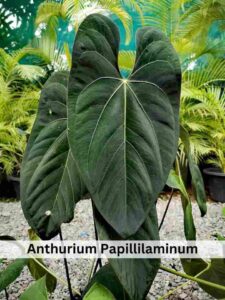
They are grown both outdoors and indoors based on the weather conditions of the surrounding area they are grown in. They are best grown indoors in colder zones. They can also be kept in hanging baskets or in terrariums and greenhouses. It is placed in a southeast location at least 3 feet away from the window to provide ideal conditions. They are slow to moderate grower and may cover a wide space if the conditions are to their liking. The leaf blade can measure up to 13.4 inches with short glossy stems. It may grow up to 3 feet tall with proper care.
It is an invasive species which may spread out from the rhizomes and offsets. It is given other names like Anthurium Papillilaminum Croat, Velvet Cardboard Anthurium. It can be grown ideally in USDA hardiness zone 9b to 11. It is seen growing quickly in its wild habitat but suffers with a slower growth rate at home. It is an extremely rare and expensive house plant which requires proper care and maintenance. So, it is not suggested for first time plant owners.
The most important feature of this houseplant is their signature dark olive green leaves which brings a tropical touch of colour and vibrancy into the home.
Botanical Classification
| Kingdom | Plantae |
| Clade | Tracheophytes |
| Clade | Angiosperms |
| Clade | Monocots |
| Order | Alismatales |
| Family | Araceae |
| Genus | Anthurium |
| Species | papillilaminum |
Anthurium papillilaminum Fort Sherman
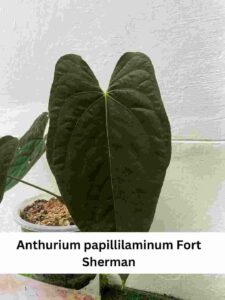
It has dark green velvety leaves, slightly veiny at the base of the lobes.
Anthurium papillilaminum Hybrid
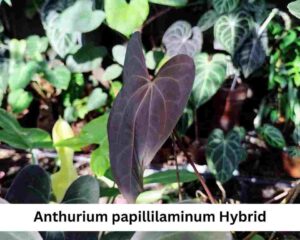
The hybrids are produced by crossing the pure Anthurium Papillilaminum with other Anthuriums. Its leaves may have the reddish sinus and the veins.
Anthurium Papillilaminum x Crystallinum
These hybrids have stunning leaves with solid white veins and tinged reddish.
Anthurium papillilaminum x Warocqueanum
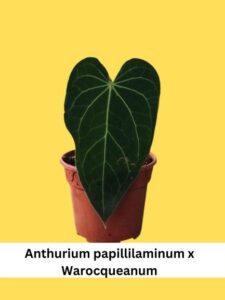
It has both dark form and green form veiny and velvety leaves. The veins have a whitish tint and run from the first basal vein. Their leaves can be really huge.
Anthurium Papillilaminum x Carlablackiae
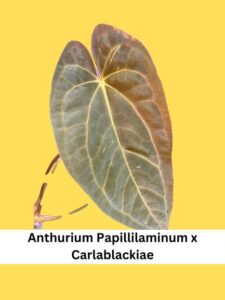
It has smaller leaves and has a brownish or reddish tint on their surface. The lobes are very close with a little space or hole in between.
Is It Toxic?
Anthurium Papillilaminum toxic to both pets and childrens. According to the University of California, Anthurium comes in third and fourth class in toxicity.The plants contain Calcium oxalate crystals which are poisonous when ingested. Its sap can cause minor skin irritations.
In humans, chewing any part of it may result in painful burning of the lips, mouth, tongue and throat. Sometimes it may also lead to inflammatory reactions and difficulty in breathing. One should seek immediate medical help on the appearance of the symptoms.
In animals like cats and dogs, it affects the oropharynx. Symptoms like oral irritation, pawing at the mouth, vomiting and drooling may appear on its ingestion. Get in touch with the vet immediately if these effects are observed.
Anthurium Papillilaminum Care
It may be an easy-to-care plant for all time gardeners to maintain all optimal conditions in time. However, it’s a great challenge for novice growers to maintain a tropic-like warm climate which is a key to achieve a healthy and vibrant plant.
Light
They grow ideally in diffused sunlight. They prefer bright indirect light at least for about 3 to 4 hours daily. You can keep the plant in spots receiving light reflected from the window, wall or curtain. Underexposure causes loss of dark pigments, leggy growth, stunted growth and leaf drop. While overexposure may cause scorching, curling and discolouration.
Temperature
They grow well in warm environments ideally between 70 degree- 90 degree fahrenheit. Make sure to keep them inside when the temperature starts dropping below 50 degrees and exceeds 95 degree fahrenheit.
Soil
Well draining moist soil slightly acidic in nature and rich in organic matter content is ideal for this houseplant. It should be able to retain enough moisture and create a slightly moist soil. Consider using cocopeats, peat moss, vermicompost, etc to increase air circulation.
Water
Anthurium Papillilaminum prefer moist soil. So, the watering should be done according to the schedule. You can water it every 9-10 days in the growing season i.e. during summer and spring. The frequency should be decreased to every 18-24 in fall and winter when the plant stops growing at its pace. However, soil should be left to dry in between waterings. Overwatering may cause water-stressed roots and under-watering leads to stunted growth and transpiration.
Humidity
It grows well in a humid environment ideally at a humidity level of at least 40% to 60%. It can be placed among other plants in a room to naturally boost humidity. Light misting during spring and summer can be done to prevent stressing.
Fertilizers
It can be grown without fertilizers as well. But, a 5-10-5 phosphorus-rich organic fertiliser can be used either in granular or liquid form in order to boost their growth once every month during their growing season.
Potting And Repotting
It can be potted in ceramic or plastic pots with few drainage holes.
Repotting can be done once in every two to three years when the plant doubles in size and the potting mix gets exhausted to replenish back the plant’s nutrients. It should be repotted when signs like yellowing and wilting of leaves, bacterial or fungal root rot, slowed growth, etc are observed.
Trimming And Pruning
It doesn’t require trimming and pruning that often. But the damaged leaves or stunted stems can be trimmed to protect other parts from being damaged.
Anthurium Papillilaminum Propagation
Anthurium Papillilaminum can be easily propagated through stem cuttings and from root division.
1. From Stem Cuttings:
A. Directly into the soil
- Start with a healthy stem with at least one leaf.
- You can cut just below the node leaving as little stem as possible using a sterilised blade or scissor.
- The cutting can be first dipped in some rooting hormone to boost up the process.
- Prepare a well-aerated and slightly moist potting mix as required.
- Gently insert the cutting into the soil.
- Cover the pot with a cover to lock up the moisture and humidity.
- The plant can be grown in normal condition once the feeder roots appear, probably within 2-3 weeks.
B. In the water medium
- Grab a transparent jar and fill it with distilled water.
- Submerge the cutting inside it.
- Keep the jar in a warm and humid environment giving indirect sunlight.
- Replace the water every week or when the water gets brown.
- Once you witness the appearance of new roots , transplant it into the potting mix prepared accordingly.
2. From Root Division:
- Once the plant reaches dormant stage, remove the plant from the pot without damaging roots.
- Cut a section of young and fresh root with a stem intact instead of a thick central root system using sharp pruning shear.
- Let the cutting dry and prepare a pot with potting mix according to their requirements.
- Insert the root into the mix and place it in a warm humid environment with indirect sunlight.
- The new roots will appear within a few weeks and the plant can be grown under normal conditions.
Common Problems
Pests
- Mealybugs: It is a cotton-like substance underside the leaves. It can be removed by dabbing with a cotton swab dipped in rubbing alcohol.
- Scales: It is brown bumpy lumps found on the undersides of leaves. It can be removed by scraping off using blunt tools.
- Aphids: Tiny grey or black insect covering the leaf. It can be dissipated by spraying it with water using a hose.
- Spider Mites: It can be picked up manually and disposed of.
- Whitefly: Sap-sucking insect. It can be picked up manually and disposed of.
Diseases
- Bacterial blight: Spray Agrimycin to treat it.
- Leaf spot fungus: Apply fungicides. Prevent overwatering.
- Root rot disease: Trim the infected part and repot it in a fresh soil mix.
- Rhizoctonia spp.: Spray fludioxonil to limit this problem.
- Browning and yellowing of leaves: Maintain proper schedule for watering and prevent overexposure to sunlight.
Price
This Anthurium species is quite expensive because of its rare nature. Its price can range from $200 to even $500 based on the number of leaves and size of stems. You can purchase it from online sites like eBay, houseofaroid,etc.
Pros
- Its velvety cordate leaves create a delightful and vibrant environment.
- It can be easily propagated through cuttings.
- Its foliar beauty can create an eye-appealing sight both indoors and outdoors.
Cons
- It is toxic to pets and childrens.
- It is expensive and very rare.
- Browning followed by yellowing of leaves occurs if the watering schedule is not followed strictly.
Conclusion
The Anthurium Papillilaminum is an exemplary beautiful rare Anthurium species. This house plant thrives in warm and humid conditions with ample of indirect sunlight. It is actually not that difficult to care for regular plant owners. However, it is really expensive and not a good choice to experiment on for new plant owners. It is not a safe choice for the ones with pets and childrens. So, Purchasing this gorgeous Anthurium is worth it if you are committed to maintaining a proper watering schedule and giving it proper attention and care.
